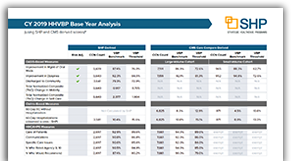In the CY 2022 HH Proposed Rule, CMS is expanding the Home Health Value-Based Purchasing Program (HHVBP) to all 50 states, the District of Columbia and all territories, effective January 1, 2022. HHVBP has been one of the few demonstration projects of the Center for Medicare and Medicaid Innovations (CMMI) that actually saved money.
CMS noted across the 9 states under the HHVBP demonstration (Demo), “The original Model has resulted in an average 4.6 percent improvement in home health agencies’ (HHAs) quality scores as well as average annual savings of $141 million to Medicare.” I can see why they would want to expand nationally. The projected savings across the next 5 years is over $3.1 billion dollars according to the projections by CMS.
With the expected implementation set to take place just a couple of months after the final rule approval in October, home health agencies (HHAs) should take the time today to understand the HHVBP model design, the proposed CY 2022 performance year outcome measures, and the calculations that CMS will be using to determine whether your agency will be eligible for a bonus or penalty up to 5 percent of your agency’s Medicare FFS revenue.
For the HHAs in the nine Demo states, the good news is that most of the outcome measures will stay the same. Only Improvement in Pain Interfering with Activity will be removed from the Total Applicable Measure Points calculations. The three new measures that are self-reported will also be removed. Other than some small changes in calculating the Improvement and Achievement points, the scoring of the Total Performance Scores (TPS) will use a similar weighting methodology, again with a few minor modifications.
The one “big change” starting next year is that the TPS scores will be compared nationally versus on a state level. If your HHA was a top performer in one of the Demo states, you were likely the recipient of positive payment adjustments. Going forward, your competition for the expanded model is every agency in the country. With this change, some agencies with bonus payments under the demonstration may now be in a penalty position. Until CMS releases the official 2019 model base year scores and later, the first Interim Payment Reports (IPRs), it may be hard to know where you stand.
One of the tables CMS provided in the proposed rule reflects their estimation of the value-based incentive payment adjustments using CY 2019 data stratified by agency size and by state. CMS will compare TPS performance based on the size of your organization defined as either a large-volume or small-volume cohort. The small-volume cohort is defined based solely on an agency’s exemption from HHCAHPS. Below is a sampling from Table 40 from the proposed rule of the large-volume cohort.
| State | # of HHAs | Average Payment Adjustment % | Payment Adjustment Percentile Distribution (%) | ||
|---|---|---|---|---|---|
| 20% | 50% | 80% | |||
| ND | 12 | 2.004 | 0.465 | 2.186 | 3.503 |
| VT | 10 | (1.145) | (2.771) | (1.555) | 0.310 |
| FL | 676 | 0.933 | (1.416) | 0.760 | 3.530 |
| NC | 152 | 0.616 | (1.285) | 0.448 | 2.613 |
| MA | 127 | (0.162) | (2.207) | (0.091) | 1.582 |
| TX | 978 | 0.154 | (3.261) | (0.090) | 2.732 |
| CA | 991 | 0.799 | (1.930) | 0.381 | 4.200 |
| All | 7,064 | 0.429 | (1.919) | 0.244 | 2.857 |
Note that based on the average payment adjustments, North Dakota is modeled to have the highest payment adjustment rate and Vermont the lowest among the 50 states. Agencies in the Demo states like Florida and North Carolina appear to be have higher adjustments on average, where Massachusetts is lower.
It will be important to evaluate the twelve OASIS-based, Claims-based and HHCAHPS measures used in the HHVBP model to track your agency’s performance against the CY 2019 base year. To help our clients, we have prepared a chart that estimates the 2019 CMS base year scores that will be used for the Achievement and Improvement Threshold Scores. Access the chart using the button below.
We accessed data from Care Compare as well as data from the SHP national database for the measures not publically reported. This will give agencies some insight regarding eligibility for achievement or improvement points that make up the TPS.
There is a lot to unpack in understanding the calculations and scope of the HHVBP national roll-out. Zeb Clayton, VP of Client Services and I will plan a webinar mid-October to review the components that drive the model and how you should prepare for the HHVBP expansion.


